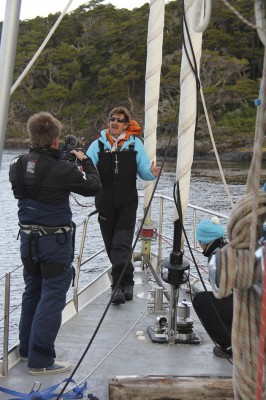56 knots of wind
Lying to a single 110lb CQR on a sand bottom in the Martial anchorage on the eastern side of Isla Herschel, we recorded 56 knots from the west during the night and by morning it was still blowing 35 knots. We hadn’t moved an inch. Skip Novak, demonstrating his safety-first mantra, had slept in the pilothouse with senses tuned to anything suggesting dragging. Such is the owner’s lot.
Early the next morning he demonstrated how to set and weigh anchor in strong winds and also explained why he prefers to use a single, preferably overweight, main anchor instead of two and an abundance of heavy chain. Keep it simple, keep it big seemed to be the ploy.
Our first taste of sailing in the strong stuff came later in the morning when we set out in 35 to 40 knots to demonstrate why Skip prefers a deep-reefed mainsail to a trysail. You’ll have to read our Storm Sailing Techniques series to find out, but suffice it to say that with seven of us aboard, it took almost half an hour to set the trysail and just over five minutes to take in a fourth reef.
At that stage the wind was topping 48 knots and with the deep reefed main and a tiny staysail (Skip’s preferred storm jib substitute) Pelagic was going well hard on the wind.
Back in the anchorage the wind strengthened more as we hunkered down and enjoyed a welcome chunk of Dolly, roasted to perfection. My log read: ‘Spume flying and clouds of spray rolling down the anchorage, but down below aboard Pelagic all is peace and warmth . . .’
By now we were judging our timing for rounding Cape Horn and decided to head for the fascinating anchorage of Maxwell on Isla Hermite where we could conduct another exercise. This involved tying Pelagic in with a cat’s cradle of long lines.
Long lines ashore
“Keep an eye open for sea otter,” said Skip as we hung off the anchorage while we went through the time-consuming business of hoisting the tender and outboard from the fo’c’s’le-cum-workshop, then assembling, inflating and finally launching it with the aid of a halyard.
Two crew sped into the anchorage with large, galvanised wire strops to be looped over suitable rocks. It’s tough work, you need full-length waders to find your way ashore through boulders and kelp and heavy-duty commercial grade gloves to manhandle the strops.
With Pelagic now following in, she was nosed just short of a bed of kelp before the anchor was dropped, leaving the chain virtually up and down. In this anchorage the shorelines would be doing the work.
So secure were we that Skip suggested the 1,000ft ascent of the nearby island of Jerdan, a tough walk which would reward us with an outstanding view. We leapt at the chance of stretching our legs and ashore encountered fairly rough and boggy terrain which made the climb a real sweat – at least for me!
Cloud and rain enveloped us and the wind screeched across the rough ground, but at the summit we were rewarded with a parting of the clouds, sunshine and the most spectacular view of the islands looking north towards the Beagle Channel glaciers and south to Islas Hornos – tomorrow’s mission.
When the weather came down it provided a reminder of the need for shore parties in this part of the world to be independent if for any reason they cannot get back to the yacht. A barrel of equipment is normally carried and the contents of this and other aspects of handling a tender in heavy weather will be one of the subjects in our forthcoming series.
We were slightly taken aback by the arrival of another yacht in the sheltered Maxwell anchorage. Skip was keen to get together with the owner, an old friend, and having failed to raise them on the VHF I was secretly relieved as a night of yarning might not have been the ideal preparation for tomorrow’s romp off the Horn.
Instead we settled down to watch the mesmerising black and white film Around Cape Horn which documents the weathering of the Cape from east to west by the square-rigged windjammer Peking in 1929. It was filmed by Irving Johnson when he was a 24-year-old, but the voiceover, also by him and spoken some 50 years later, is so colourful and brilliantly descriptive that the monotone delivery became etched in our minds for the rest of the trip. For us Skip Novak epitomised the modern day clipper skipper!






